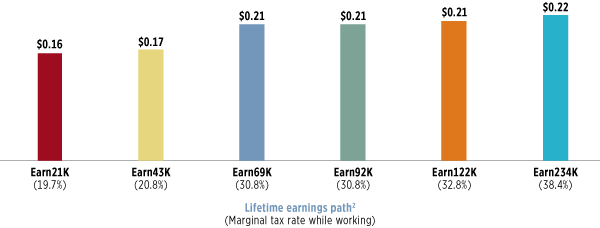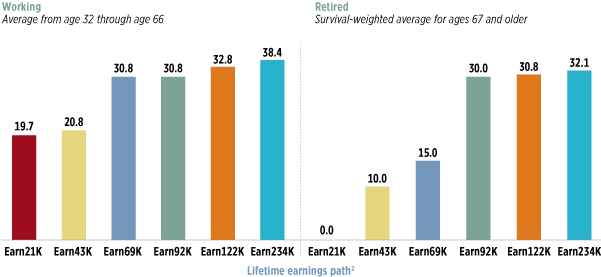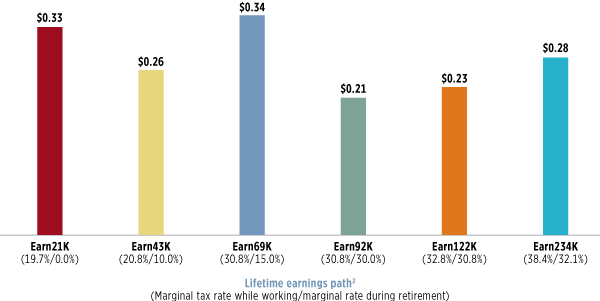ICI Viewpoints
How America Supports Retirement: What Do Tax Rates Have to Do with the Benefits of Tax Deferral? Less Than You Think
Third in a series of ICI Viewpoints.
In my new book, How America Supports Retirement: Challenging the Conventional Wisdom on Who Benefits, I set out to gain a comprehensive view of how government policy supports American workers as they gather resources for retirement. In the first two ICI Viewpoints articles on the book, I’ve shown how Social Security’s benefit formula drives participation in tax-deferred employer-sponsored retirement plans, and demonstrated that the combined benefits of Social Security and tax deferral are progressive—in other words, that government programs for retirement provide benefits that are larger as a percentage of lifetime earnings for lower-earning workers than for higher-earning workers.
My research also addresses some of the conventional wisdom that creates myths around tax deferral and its benefits. In this article, I’ll tackle one of the most widely held, and often-repeated, erroneous beliefs related to tax deferral: that higher-paid workers get more benefits from tax deferral because they face higher marginal tax rates and get more “bang for the buck” for each dollar contributed.
This belief has even led to proposals—like those in the president’s budget for the past five years and former House Ways and Means Committee chairman David Camp’s 2014 tax reform plan—to limit the up-front benefit of retirement contributions for high-income workers. For example, the proposal in the Administration budgets would “cap” the federal tax savings for workers in the top three tax brackets to 28 cents for each $1 contributed.
Unlike a deduction or an exclusion, however, the benefits of tax deferral are not determined solely by a worker’s marginal tax rate. In fact, in my analysis of six representative workers, the three lowest-earning workers would benefit more, on average, from contributing an extra $1 to their 401(k) plan than their three higher-earning counterparts would.
A Basic Misunderstanding of the Benefits of Tax Deferral
The typical explanation for why higher earners benefit more from tax deferral is as follows:
- A worker in the 35 percent tax bracket who contributes $1 to a 401(k) plan gets 35 cents in immediate benefits (in the form of lower income taxes).
- A worker in the 15 percent tax bracket who contributes $1 to a 401(k) plan gets only 15 cents in immediate benefits.
This is an excellent explanation of the benefits of a tax deduction (such as the mortgage interest deduction) or a tax exclusion (such as the exclusion of employer-paid health insurance premiums from income).
But this explanation doesn’t apply to tax deferral. Retirement plan contributions are tax deferred—not tax free.
A tax deduction or exclusion affects a taxpayer’s bill to the IRS only once—in the year that the mortgage interest is paid or the health insurance is provided. But as explained in the previous entry in this series, tax deferral affects tax liability over the course of the worker’s lifetime. Though workers get an up-front benefit from excluding retirement plan contributions from income in the year of the contribution, and get a benefit from deferring taxes on investment returns within the plan, they also pay taxes on withdrawals from the plan. So, though tax deferral may look like a deduction or an exclusion up front, the benefits of deferral are much more complicated.
In addition to a worker’s current marginal tax rate, many other factors affect the benefits, including the individual’s marginal tax rate when they take a withdrawal.
Marginal Benefits of Tax Deferral Do Not Track a Worker’s Marginal Tax Rate
Even if a worker’s marginal tax rate remains the same in retirement, the marginal benefits of tax deferral (the benefits of deferring an additional $1 of compensation) are not a simple function of a worker’s marginal tax rate.
The figure below illustrates the present value of the extra after-tax income that six representative workers, with varying levels of earnings, enjoy if they contribute an extra $1 to their 401(k) plans at age 50 and withdraw the $1 and its earnings at age 71. The conventional wisdom would suggest that the benefit for the lowest earner (Earn21K) would be 19.7 cents—based on the worker’s combined federal and state marginal tax rate—while the highest earner, Earn234K, would enjoy a 38.4 cent benefit, almost twice as much. This is an accurate description of the effect on taxes in the year a contribution is made, but it ignores both the benefit the worker gets from deferring tax on the investment income generated by the contribution, and the taxes incurred on 401(k) plan withdrawals.
In fact, do the math and you’ll see that if a taxpayer’s marginal tax rate is the same in retirement as it was when the 401(k) contribution was made, the tax paid on the withdrawal exactly offsets, in present value, the tax that was saved when the contribution was made. As a result, the tax benefit from tax deferral can be seen as effectively getting a zero tax rate on investment income.
Stated more precisely, the benefits are equivalent to getting a zero tax rate on investment returns earned by investing the after-tax equivalent of the tax-deferred contribution. That’s an important qualifier, because the after-tax equivalent of the tax-deferred contribution varies with the worker’s marginal tax rate—and that effect favors lower-earning workers.
Consider two workers, each with $1,000 to contribute to a 401(k) plan. For the worker in the 25 percent tax bracket, the after-tax equivalent of that $1,000 is $750—so the benefit of tax deferral is an effective zero rate of tax on the investment returns on a $750 investment. For a worker in the 35 percent bracket, however, the after-tax equivalent of $1,000 is just $650. So this higher-bracket earner is also getting an effective zero tax rate on investment returns—but on a smaller investment base.
Thus, as marginal tax rates increase, there are two offsetting effects: workers with higher marginal tax rates benefit more from the effective zero tax rate on investment income, but the amount of investment income to which the effective zero tax rate applies is lower.
As a result, the marginal benefits of tax deferral (assuming the same tax rate in retirement as when working) do not increase in lockstep with an individual’s marginal tax rate, as the figure below shows. The lowest-earning worker gets 16 cents of benefits; the highest-earning worker faces a marginal tax rate that is nearly twice as great, but gets only 22 cents in benefits—about one-third higher than the benefit enjoyed by the lowest-earning worker.
Figure 1
Even If Marginal Tax Rates Are Constant, Marginal Benefits of Deferral Are Not Proportional to Marginal Tax Rates
Calculated present value of marginal benefits of an additional $1 contribution to a 401(k) plan at age 50, assuming marginal tax rate in retirement is the same as when working, by lifetime earnings1

1Calculations assume additional contributions are invested in bonds earning 5.8 percent nominal interest and that assets are distributed at age 71.
2The lifetime earnings paths of the representative workers are based on the earnings paths derived in Brady 2010. See this ICI Viewpoints for additional detail. Reported marginal tax rates are average marginal tax rates from age 32 through age 66 from the baseline simulation (see Figure 2, below).
Source: ICI calculations
A Bonus Benefit from Retirees’ Lower Tax Rates
Those numbers assume a constant marginal tax rate from work years through retirement. But in fact, all six workers face lower marginal tax rates when they are retired, because they have lower total income in retirement and because only a portion of their Social Security benefit payments are taxed as income.
Figure 2
Representative Workers’ Marginal Tax Rates Are Lower in Retirement
Marginal tax rates1 for representative individuals under current policy baseline by lifetime earnings,2 percent

1 Marginal tax rates are calculated using statutory tax rates, but the federal statutory rates are adjusted for interactions with the limitation on itemized deductions, the alternative minimum tax (AMT), and the phaseout of the AMT standard deduction. For taxpayers who are not subject to the AMT and who itemize deductions, combined federal and state marginal tax rates are adjusted to account for the deductibility of state income taxes. For taxpayers who are subject to the AMT (which does not allow for the deduction of state income taxes) or who do not itemize deductions, the combined marginal rate is simply the sum of federal and state marginal tax rates. Rates plotted are the representative workers’ average marginal tax rates during the period covered (age 32 through age 66; or ages 67 and older).
2 The lifetime earnings paths of the representative workers are based on the earnings paths derived in Brady 2010. See this ICI Viewpoints for additional detail.
Source: ICI simulations
That drop in marginal tax rates on withdrawals gives all six workers a bonus—the tax paid on the withdrawal in retirement is less, in present value, than the tax that was saved when the contribution was made.
Consider a worker who contributes $1,000 to a 401(k) plan, and who faces a 25 percent marginal tax rate when working and a 15 percent rate in retirement. The benefit of the $1,000 contribution would be equivalent to (1) getting zero rate of tax on the investment returns on a $750 investment (as explained above), plus (2) a bonus equal to $100, in present value. (The $100 represents the 10 percentage point drop in marginal tax rates in retirement multiplied by the $1,000 contribution.)
Note that rates fall far more for the three lowest earners—by half for Earn43K and Earn69K, and all the way to zero for Earn21K—than for the three higher earners. When the fall in marginal tax rates is taken into account, all six workers get greater benefits than they would with no change in tax rates—but the “bonus” benefits are greatest for the three lowest earners.
To further illustrate this, the figure below shows the marginal benefit for these six workers of adding $1 to each one’s 401(k) account, taking into account the drop in marginal tax rates in retirement.
Figure 3
Accounting for Change in Marginal Tax Rates, Workers with Lower Lifetime Earnings Typically Get Higher Marginal Benefits
Calculated present value of marginal benefits of an additional $1 contribution to a 401(k) plan at age 50, accounting for change in marginal tax rates during retirement, by lifetime earnings1

1 Calculations assume additional contributions are invested in bonds earning 5.8 percent nominal interest and that assets are distributed at age 71.
2 The lifetime earnings paths of the representative workers are based on the earnings paths derived in Brady 2010. See this ICI Viewpoints for additional detail. Reported marginal tax rates are average marginal tax rates during the period covered (age 32 through age 66; or ages 67 and older) from the baseline simulation (see Figure 2, above).
Source: ICI calculations
The three lowest-earning representative workers would benefit more, on average, from deferring an additional $1 of compensation. This result arises because:
- As illustrated in the first figure, lower-earning workers get less benefit from the effective zero rate of tax on investment returns, but the differences are not proportional to the difference in marginal tax rates.
- The lower-earning workers experience the largest drop in marginal tax rates during retirement—which gives them a larger “bonus” benefit and more than offsets the lower benefits they receive from the effective zero rate of tax.
Social Security Benefits Drive Savings—And the Benefits of Tax Deferral
As the second post in this ICI Viewpoints series showed, the total benefits of tax deferral do increase with lifetime earnings. But the reason higher earners benefit more from tax deferral is not that they get more benefits on every dollar they contribute to a retirement plan; rather, it’s because they contribute more dollars. And (as the first piece in the series explained), the reason that higher earners contribute more dollars is because Social Security replaces a lower share of their earnings.
The Social Security benefit formula causes workers with higher lifetime earnings to rely more on—and to benefit more from—tax deferral. Because Social Security benefit payments replace a smaller share of their pre-retirement income, higher earners need to save more, to ensure that they meet the target replacement rate of their income in retirement.
Myths Can Be Hazardous to Your Retirement
To recap: higher earners benefit more from tax deferral because they contribute more dollars, not because they get larger benefits per dollar. The design of the Social Security system, not the design of the income tax, is the primary reason that benefits of tax deferral increase with lifetime earnings.
In my book, I go on to explain how proposals based on the marginal-benefit myth—such as the proposals included in the president’s budget and in Chairman Camp’s tax-reform proposal, which would limit the up-front benefit of tax deferral—would harm retirement savers. Those proposals, like the myth itself, are rooted in a fundamental misunderstanding of tax deferral—a misunderstanding I hope to lay to rest.
In the next and final piece of this series, I’ll address another misunderstanding and myth—the idea that incentives to save for retirement are “upside down.”
Additional Resources:
How America Supports Retirement
Other Posts in This Series:
- How America Supports Retirement: Tackling the Myths That Surround Us
- How America Supports Retirement: No, Benefits Are Not “Tilted” to the Higher Earners
- How America Supports Retirement: What Do Tax Rates Have to Do with the Benefits of Tax Deferral? Less Than You Think
- How America Supports Retirement: The Incentive to Save Is Not Upside Down
Peter Brady is a Senior Economic Adviser at ICI.
